Fashion Graduates 2019 Round-up
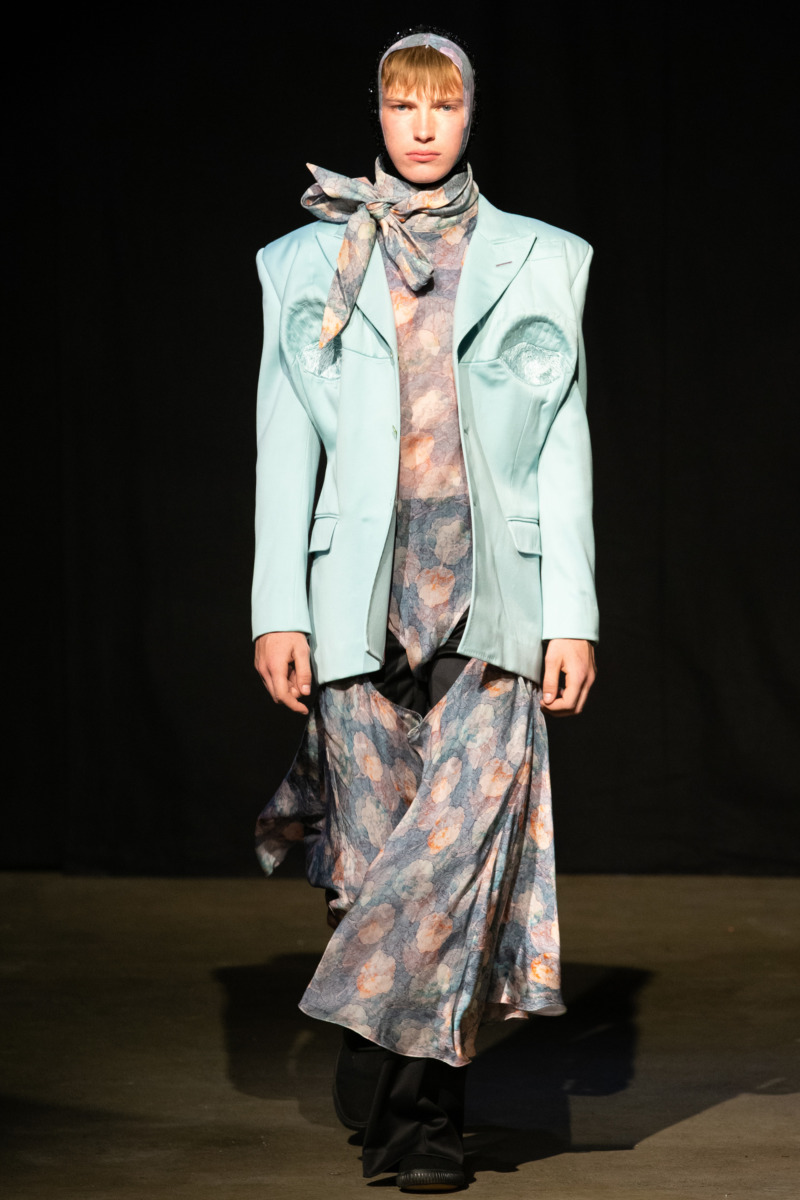
This season, we saw students push the boundaries of fashion: they did away with the invisible limits of menswear, explored the possibilities of construction, salvaged waste fabrics in the name of sustainability, all while taking inspiration from their personal tales and far-off eras alike.
Now, as they break for summer and move out from under the umbrella of institution, we take a moment to look back at the designers who left us in anticipation of a new season. Speaking to four upcoming designers from four different colleges, we learn more about what inspired their collections, their plans for the future and how their school shaped them as designers.
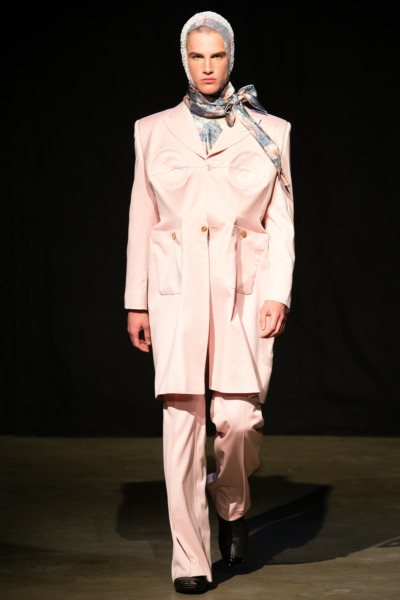
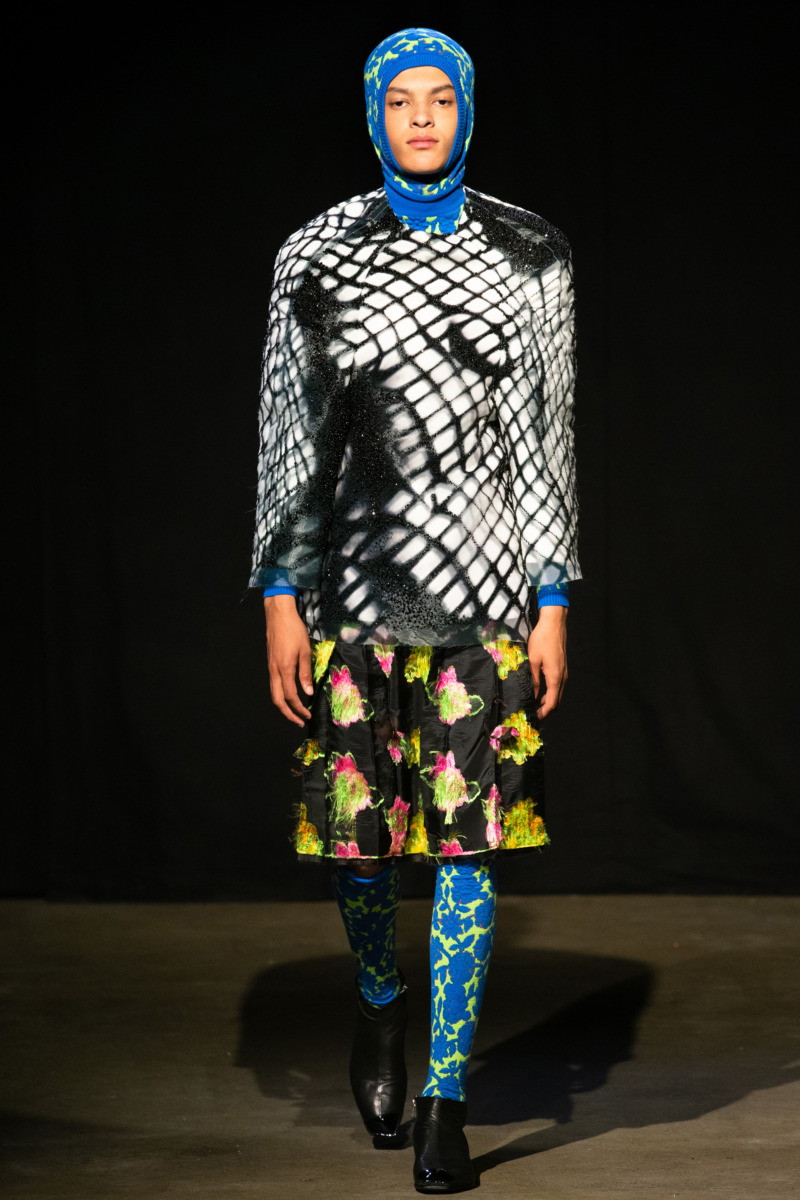
Curtis Wu
Your MA graduate collection is a stimulating mix of decadence, delicacy and elegance but not without a whimsical tone. How did your fascination with these themes begin?
Well, I think the difficult part for me was gathering material, information and references at the beginning. Actually, I start from myself to be honest: my dress style, my own wardrobe, my personality or my even my iPhone album. I always screenshot interesting images when I’m online, so I just start to look at thousands of photos, and think, “oh this coat is amazing”, “oh this shape is great”, and “yes this lady at the store is fun” and think, “If boys wear this dress, it’s gonna be interesting”. So I print them and then deeply research them, then the story is being made up.. Then there’s lots of styling, drawing, photographing, sampling etc.
And yes, I really enjoy visiting vintage stores, I mean like real vintage stores, not last year garments market, they help me a lot to see the details, fabric, and construction.
You previously interned at Simone Rocha. What was that experience like and how did it contribute to your growth as a designer?
That was a meaningful experience for me last summer. I saw and learned a lot. I saw how a studio works and how people play their own role in the company. I learned how a few pieces become 40+ looks, and how to organize the team. I got lots of help from friends, industry people, shoemakers…
From inverted lady-shaped blazers to 3D floral swimsuits, your collection is an exuberant defiance of the traditional male silhouette. Going forward, how do you want to redefine menswear?
The value of the garments resides in the fact that people look beautiful and comfortable when they are wearing them. I think future menswear could be more personalized or more couture; fashion is a rebirth, and when people will get tired of “common” clothes, they will always look for some interesting and new designs.
Whether it is the 40.000 Swarovski crystals that took 200 hours to embroider on a coat, the hand-stitched tailored blazer or the recycling of second-hand pieces and beads, it is enough to prove that besides creative design and exciting stories, our younger generation has still not let go of pursuing exquisite craftsmanship and sustainability.
Who are some male/female muses that influence you as a designer?
I always have a lot of muses in my mind. For this masters collection, Little Edie from Grey Gardens and Stephen Tennant were my main muses. Edie always wore a bandana and swimsuit even though she lived in squalor; she still dressed so well every day. Stephen suffered from tuberculosis but couldn’t care less what people thought about his finger waves, his Charles James blazer, his makeup (“I want to have bee-stung lips like Mae Murray”), or his dyed hair dusted with gold. Who would have dared to criticize his aristocratic privilege? Or his self-described “fatal gift of beauty”? They both reveal decadence in part but they also show unusual delicacy – which quite reflects me.
On your Instagram, you’ve posted a few photos that show how your collection came together, from the sketches to model fittings and close up detail shots of your designs. Could you talk us through this design process and how it all came together? Did you struggle with any part, in particular?
Yes, I bought lots of vintage pieces and a quarter of material, I styled them, mixed them, took photos, and I started to draw and collage. I toiled lots of fittings and re-toiled, tried on different models, did fabric manipulation, tried different fabrics in the same shape, and noted them.
I think the fitting part was quite tough. In order to find the perfect proportion in a man, it takes a lot of fittings – like that inverted lady-shaped blazer, I toiled about 20 times in calico, soft fabric, hard fabric, with canvas and without canvas.
As opposed to doing a BA, what kind of challenges did you have as an MA student?
We have a creative ideal in the BA so we just make clothes, but in the MA we have to think about how to make every idea connect, to make a whole story. Fitting is important in the MA; we spend a lot of time fitting, we fit the model and fit a ‘normal person’ because we are not going to sell to only models so we make a production version for selling. I also think about sustainability. Fashion needs designers to save resources and recycling which I ignored in the BA.
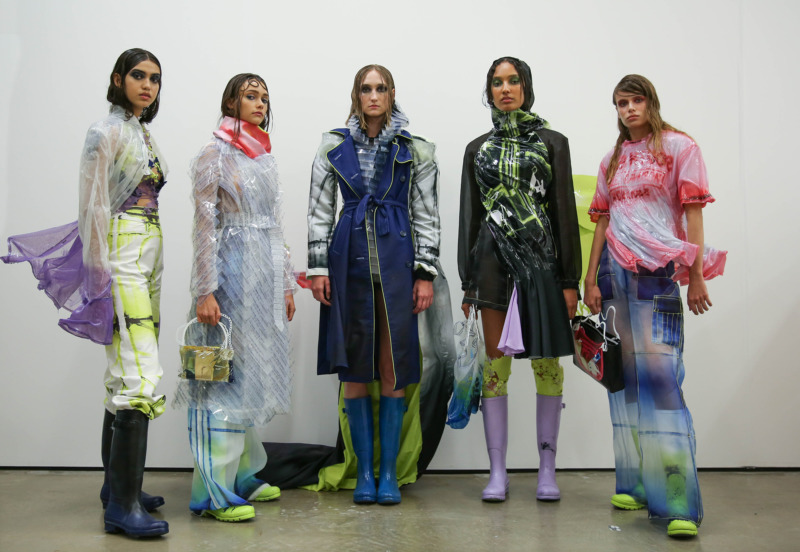
Grace Jean-Louis Constantine
You’ve mentioned previously that the garments from your BA collection look as though they’re caught “in the eye of the storm”. Can you talk us through this inspiration?
My collection explores the relationship between a mother and daughter. This relationship can be described as loving, nurturing and protective, especially during times when you feel exposed or in crisis. My personal experience with my own mother has been all these things for me. However, there was a long period where these roles had been reversed; when I have had to be the carer. Not only did our relationship change during this time, but the way I saw my mother also changed. Someone who had always been a strong, single mother, became frail and dependent on me.
I have used this ‘role reversal’ as a visual indicator for my research. For example; researching garments that are associated with protection and resilience or comfort to represent my mother. These include leather clothes, armour references, coats and scarves. I have then explored different ways of changing these garments to suggest the role reversal that occurred. This has been achieved by imagining garments in the ‘eye of the storm’ and how that would affect them. The shapes represent normally immovable and ‘hard’ clothes to have now become susceptible to the elements, particularly directional wind and rain. For this, I referenced old master statues that were able to capture motion statically. I was drawn to how these sculptors effortlessly depicted hair and fabric moving in the wind, or dripping in rainwater, and I wanted to emulate this in my own collection. I interpreted this in quite a literal way and started creating moulded garments that similarly evoked movement in a fixed position.
The prints have also been used to represent the delicate nature of the garments when ‘exposed to a storm’. To achieve this, I created my own visual research through photography to expose the garments and objects to different lights. For example, cyanotypes, photograms and most importantly, x rays. I found the x-ray to be the most successful process as the outcomes could show the inner workings of the garments and the fragility I wanted to depict.
What kinds of challenges did you face in creating this collection? How did you overcome them?
The first challenge was creating my own imagery. I needed to explore how clothes move in the wind and have a bank of images that I could reference when moulding the garments that you couldn’t get from secondary research. So, I had to find a very willing model who would allow me to dress her in the clothes and point a leaf blower at her for hours and throw water on her. Similarly for the prints, I initially started fiddling on photoshop to create the x-rays because I didn’t have access to an x-ray machine. But I felt dissatisfied with the inauthentic outcomes and became obsessed convincing a hospital to let me put objects in their x-ray machines, which was a turning point for the collection when I finally did. However the biggest obstacle was understanding how to mould the garments to look effortlessly wet and moving. It’s all well and good creating samples but translating that in a wearable piece that a moving body can walk in is another issue. It became quite a technical process as the moulding agents had to be different in different parts of the garment. For example, extremely hard in certain areas to create the ‘blown in the wind’ effect I wanted, then soft in others so that the garment could still bend to allow the body to get into it. Also some of the garments where two pieces such as the pink t shirt, so I had to mould the pieces so that would successfully interact with each other stay flush on the body.
What have you learnt working at Maison Margiela as a design assistant?
So much! My process definitely developed after spending a year there. The artisanal collection allows for each garment to build a story and its very important to John that this is authentically executed. Seeing how this achieved from concept, research and development was really inspirational. I think it’s also why I became quite reliant on creating my own research and imagery so that my own work could hopefully authentically depict movement and exposure. I am very grateful to have seen and learnt from that way of working.
How has your time at Central Saint Martins developed you as a designer?
I feel really lucky to have studied Fashion Print at CSM because it allows you to have two specialisms in both design and print making and ultimately be able to work with both in tandem. Also because the university offers such a variety of courses you have access to a lot of different disciplines which can be incorporated into your work. There is always a lot of space to interpret fashion in whatever way is relevant to you or your concept which could include any process you deem necessary. For example, during my final collection I spent a lot of time in the casting workshop developing the moulded pieces that I don’t think I would have thought of, or had to confidence to do if I hadn’t had two previous years of playing around in the building with the different disciplines.
With your BA graduate show behind you, what are you most looking forward to doing next?
I already have itchy fingers and need to get stuck back into something. I’m moving back to Paris to start my new job, so I’m excited to see what new challenges that will bring!
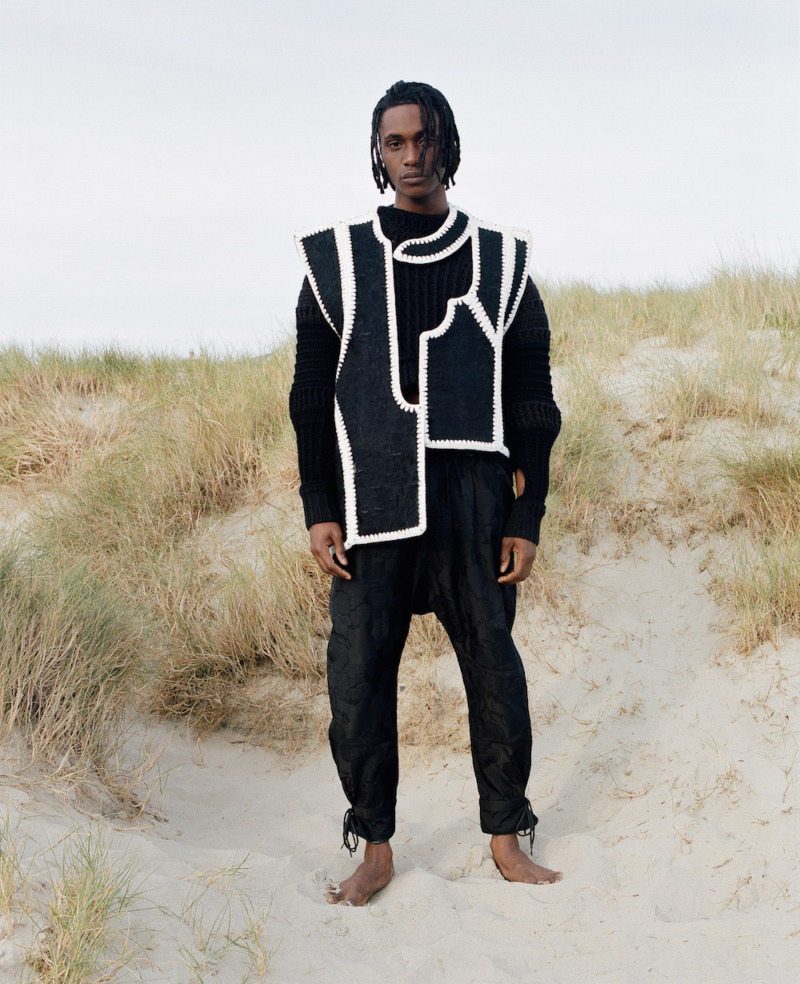
Gráinne Walley
Your MA collection at RCA “Lámh 1” features a mix of crochet, knitwear and leatherwork. What was your motivation in using these more traditional techniques?
After completing my BA at NCAD in Dublin, I wanted to up-skill and learn traditional tailoring and construction techniques to feed my work. I was given the opportunity to work alongside a highly skilled team of costumiers in 2016 on MGM’s production Vikings. The quality and standard of make were inspiring, as everything was made authentically by hand. I loved the use of traditional techniques, it was amazing to watch history inspire innovation. This was something I always wanted to bring with me to the RCA for my MA; innovation stemmed from tradition.
Can you give us an insight into why the collection is called “Lámh 1” (‘hand’ in Irish)?
This collection is an ode to the handmade. I have always tried to create garments that show the trace of the maker, as a reminder to the wearer of the presence of the human behind it. I think the fashion industry can often be regarded as an industrial machine and it is possible to forget the human hand within it. This collection is an effort to show off the capabilities of the hand as our most powerful tool.
Between studying at NCAD in Dublin and RCA in London, what has the learning curve been like for you as a designer?
NCAD and the RCA have a very similar educational ethos. Both encourage interdisciplinary collaboration and discourage hierarchical boundaries between students and tutors. We are always told to act as designers, not as students and to embrace the freedom and responsibility of being a designer. We are pushed to always have an opinion and to show initiative, and never wait to be told what to do.
As an Irish designer and having previously taken up an internship with prominent Irish designers John & Simone Rocha, how do you feel your heritage impacts your work?
I learned so much while working for John and Simone, it was such an invaluable experience. It might be because I was so young when I started but I always felt it was like working and feeling part of a family. I think I would be similar to a lot of Irish designers, in that my heritage comes out in ways that I wouldn’t necessarily expect. It isn’t always my intention to draw inspiration from my homeland, but somehow it naturally finds its way into my work, which I love. I always consider the Irish to be open, genuine and “what you see is what you get”; always with a sense of humour attached. This is something I have always tried to bring into my work, a sense of playfulness and lightheartedness fused with authenticity.
Now that you’ve completed your graduate collection, what can we look forward to seeing from you?
The big one. I’m currently looking for a studio space in London, one that also serves as a showroom that is open to the public. Something that provides a sense of intimacy and transparency that would be in tune with my work. I am really excited to be starting my own brand in London, as it feels like I’ve been building up to it for years. I am also currently working for Bianca Saunders and for myself on my next collection as I will be holding a presentation next year.
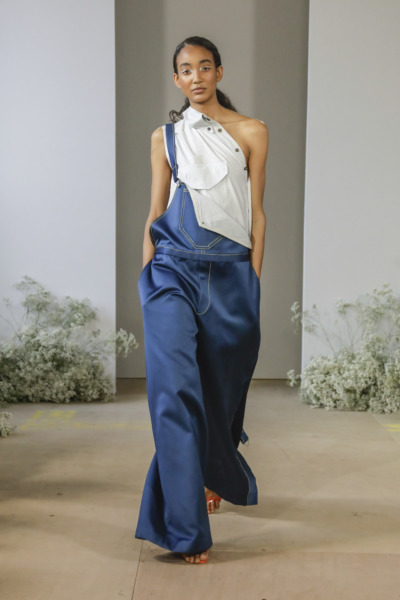
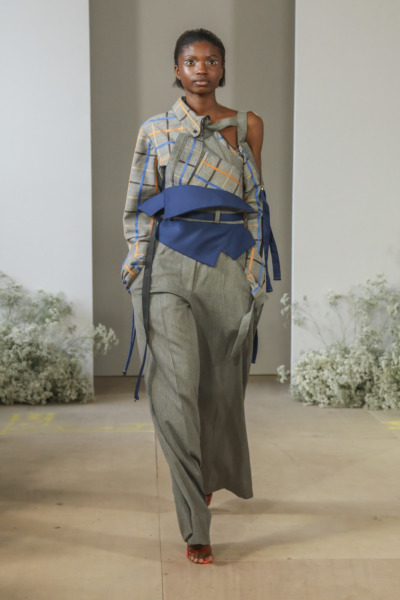
Myrkida Harris
How do you think coming from St. Lucia has influenced your outlook as a designer?
I love my island and would say that my love for fashion was influenced and shaped largely by our rich culture and the beauty of nature on the island. Despite its richness in natural beauty, not a lot of importance is placed on the arts and many of my friends and family were left shocked when I told them about my decision to pursue a career in fashion design and do a fashion design degree in the UK. My outlook on fashion coming into London changed tremendously and inspired me as a designer. Coming to London exposed me to new experiences, new art forms and people and gave me the freedom to express myself through my work.
Your collection plays with the idea of movement and features an entertaining mix of textiles. Can you talk us through your design process in relation to these motifs?
I have always had a soft spot for conscious designing and wanted this to be reflected in my work, therefore, instead of sampling with new fabric, I deconstructed various styles of ready-made garments for my sampling and experimented with different methods of draping with the different textiles until I found designs that perfectly captured my theme of ‘Distortion’. The movement and flow of the motifs came organically as I played with different looks.
Your runway looks, from the designs to the styling, exude a sense of ease and cool elegance. Are there any female muses that may have influenced your collection?
My mom! She has been a great influence on me and my work. She exudes both elegance and creativity in her style and is one of the most creative people I know. I am pleased to have gotten my creative flare from her.
I have also been inspired by celebrity influencers like Keke Palmer and Rihanna, who emanate elegance and confidence through fashion. I try to reflect these styles in my work.
You note American fashion designer Thom Browne and British painter Lucian Freud as inspirations for your graduate collection. Can you elaborate on how you brought these influences together?
I did a small project on Lucian Freud in my foundation year and fell in love with his work and his rebellious and free spirited drawings.
Thom Browne’s creativity is a gift to this world; I was able to relate to his Fall 2019 collection as it captures the style I like as a designer and the story I want to tell with my clothing. I consider his work well thought out, precise and elegant; the styling I also wanted to bring to these garments.
I combined and mimicked both styles of work; Frued’s style of painting by layering thick mounts of paint, by layering my garments and Browne’s fusion of styles and garments it allowed me to elegantly blend a ‘normal’ garment into garments that were seemingly abnormal.
How do you feel now that you’ve completed your graduate show? What do you hope to accomplish going forward?
It has honestly been a bittersweet moment. I have never felt so relieved yet stressed at the same time. I can’t say I have a clear direction mapped out for me but I am making strides towards making it into something I can be proud of. I hope to gain as much experience in the field as I can and take hold of every opportunity to showcase my work that comes.
